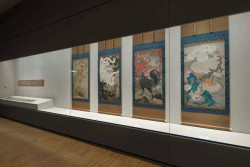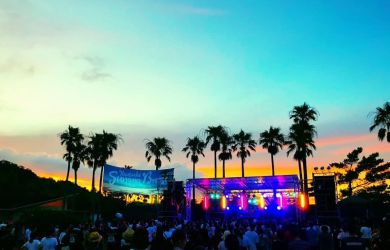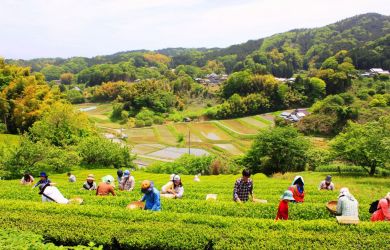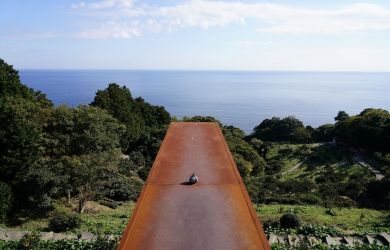
October 16, 2003
Tropics of Interest
Urban escapees in search of a little anonymity are drawn to Ishigaki-jima. Simon Rowe finds out why.
By Metropolis
Originally published on metropolis.co.jp on October 2003

Photos by Simon Rowe
Just like relatives, you can’t choose your bunkmates when it comes to long-haul ocean journeys. Especially if you’re a passenger aboard the Okinawa Car Ferry, a huge roll-on, roll-off iron maiden that sails throughout the remote and wildly tropical islands of Okinawa Prefecture. My bunkie’s name is Horiguchi, a middle-aged interior designer from Tokyo, whose shaggy hairdo and sweat-drenched clothes gave no hint of his profession. He probably intends it that way.
Many of the browbeaten mainlanders making the 16-hour journey from the steamy port hub of Naha, Okinawa’s administrative center, to Ishigaki-jima in the Yaeyama islands group, are urban escapees seeking a little anonymity. Serenity and soul food, too, are high on their lists. Horiguchi-san’s soul food seems to come from out of the Nikka whisky bottle he has tucked in his duffel bag. Serenity, needless to say, never comes for any of us in bunk rows 24-30. Horiguchi-san is a human foghorn; his snoring could stop a supertanker in its wake.
Foreign terrain
Not until the ferry nudges up to the blistering docks of Ishigaki township do you realize you have entered a very un-Japanese part of Japan; fiery-red flowering trees line the streets, the air is hot and salty, and the mainly farmer-fisher inhabitants are stockier, darker-skinned and more curly-haired than their northern countrymen. The Shinto-Buddhist influence is also less prevalent. Ishigaki-jima’s shrines have none of the somber altars, gilded statues and incense-stained scrolls which fill Kyoto’s grandiose temples and shrines, only an empty pavilion hidden by tropical vegetation, and home to birds, insects, and the odd reptile.

“Shamanism is a strong part of Yaeyama culture,” says Miyako Ohama, who moved from Kyoto to Ishigaki-jima more than 20 years ago. “Islanders worship tree gods, water gods, fire and mountain gods. There’s no need for symbolic representations since the gods are everywhere.”
Leaving the port, head through a maze of narrow streets filled with ugly concrete low-rise buildings and the odd weathered wood house and you’ll come to Guesthouse Rakutenya, the inn managed by Miyako and her husband Ren. Eighty years ago this charming old weatherboard building was a cider factory. These days, with its outer walls seemingly held together by a tangle of vines and hibiscus flowers, it offers an atmospheric pit stop for budget travelers planning a day or two on Ishigaki-jima.
“The same rigid social system which dictates daily life on the mainland doesn’t exist here. I think people are happier and far less stressed for it. There’s less pressure to keep up appearances,” Miyako tells me later, over an icy Orion beer in a neighborhood pub. Okinawa has the highest number of centenarians in Japan and while they might not be as well-heeled as Honshu folk (Okinawa is also the poorest province, per capita), they certainly seem healthier and more content.
Fish, fruit and fried vegetables are the daily staple and rare is a menu that doesn’t include goya champuru, the bitter green melon that resembles a nobbly-skinned cucumber and is served lightly fried with egg and onion. “It’s a popular remedy for natsu-bate [summer fatigue]. It cools your blood,” encourages the matronly waitress at Ma-sando, a harborside restaurant whose name means “delicious” in local Yaeyama dialect.
Service at Ma-sando might be a little on the slow side, but then what can you expect when most of Ishigaki-jima’s 45,000-odd inhabitants have their watches set to “Okinawa time.”
Time capsule
“If you’re late, you’re not really late. One’s concept of time here is different to the mainland,” says the man at Ai-Ai Bicycle Rentals. “Bring it back anytime after dinner,” he says, tossing me the keys to one of his mountain bikes. Fallen bean pods and nuts crackle and pop beneath my tires as I follow the cross-island highway north from Ishigaki and its tiny, inter-island airport. Fields of cane sugar, tobacco and coffee bushes-scenery more in keeping with Latin America-roll on and on.
Where the rolling green farmland meets the raggedy coastal jungle, the village of Shiraho begins. After Ishigaki’s languid typhoon-proof concrete suburbs, the quaint laneways and riotous gardens of hibiscus and tiger lilies are refreshing.

Unlike other islands, which have replicated traditional Yaeyama architecture, Shiraho’s expansive single-storied wooden houses are maintained faithfully to their original state. Set on low stilts, with wide verandas and ample sliding doors to allow sea breezes to circulate easily, these heavily-tiled houses all share intriguing thing: a shiisa.ÊThe fierce-looking clay lion-dog, brightly painted in red and white, sits atop roof tiles throughout Okinawa to ward off evil spirits, but in Shiraho they are especially scary. The coral rock walls surrounding each house to keep in the menageries of chickens and goats hardly seem necessary.
Goat noodle soup, or hija jiru, is likely what becomes of runaways. At Tony Soba, a small corner diner set back from Ishigaki’s port, it’s the specialty. The boss, chef and waiter is a little man with a loud voice and nut-cracker handshake. He’ll spin you yarns all afternoon long should you decide to hang around. And while the black-and-white photos of him wrestling giant tuna, or smiling from the window of the wheelhouse in mountainous seas off the coast of West Africa, lend some currency to his long-winded tales, I decide not to.
Getting there
Ishigaki-jima is located in the extreme southwest of Okinawa Prefecture. Direct flights run from Tokyo (3hr 25min), and Okinawa’s capital city, Naha (1hr). Airfares range from ¥20,000-¥60,000 depending on the season. The Okinawa Car Ferry runs twice weekly from Naha; the trip takes 16hr and costs ¥5,000 one way.
Where to stay
Guesthouse Rakutenya (tel: 0980-83-8713) is 10min walk from the port and 10min by taxi from the airport. Guests can take a simple room with tatami mats, roll out on a futon for ¥3,000 and wake up to the unfamiliar sound of a beachcomber’s mobile. The staff speak English.
More information
Rough Guides (www.roughguides.com) and the Japan National Tourist Organization (www.jnto.go.jp) both offer useful travel tips for the Okinawa Islands. Public buses on Ishigaki-jima are few and far between. Mountain bikes can be rented from Ai-Ai Bicycle Rentals (tel: 0980-83-9530), opposite the Central Post Office, for ¥1,000-¥1,500 per day.
Ma-sando (tel: 0980-83-4050) is located on Shiyakusho Street, behind the port. Recommended is the toku-toku course (¥1,500), which includes regional favorites like mimiga (julienned pig’s ear in a vinaigrette), goya champuru, sunui (tangy seaweed), and rafute (slow cooked pork in a miso-like sauce). Tony Soba (tel: 0980-92-5838) is nearby and open 8:30am-11pm.
[geo_mashup_map]





